When was the last time you checked your vehicle to see if you have low tire pressure? If you have a car younger than 12 years old, it is probably equipped with an onboard tire pressure monitoring system. Yep! That’s the little yellow tire pressure light just like the image below.

Newer models, however, have sick tire pressure monitoring system display!
Take a look at this console from an Audi.
It individually displays tire pressure and temperature. That's cool! If you have a lead foot and you accidentally got into a highspeed highway police pursuit, you would see how hot your tires are, and pre-emptively jump from the car like an action star before your tires fail!

Kidding aside, some car manufacturers have taken safety and made internal function monitoring readily available from the car console with more details. But still, even the primary tire pressure monitor system light (TPMS light) is a great feature to have.
Now, to the more exciting topic, In this Ultimate Guide, let’s discuss the importance of why you need to maintain your car’s tire pressure.
Another important note, especially for older cars, there’s a topic about tire pressure sensor fault. Aside from your tire pressure, the pressure gauges must be checked too! Moving on!
1. What does Low Tire Pressure Mean
Can you imagine how amazing compressed gas is? Well, it can fill up and inflate your tires. What about that? Our tires are filled with pressurized air and carry the weight of the vehicle, including the passengers!
Now, how much air do your tires need? To be safe, car manufacturers have recommendations depending on the road condition, load weight, and weather. A graphic chart can be usually found on the opposite side of the door look on the driver’s side.
Here is an example of a tire-loading guide of a Toyota Hilux.
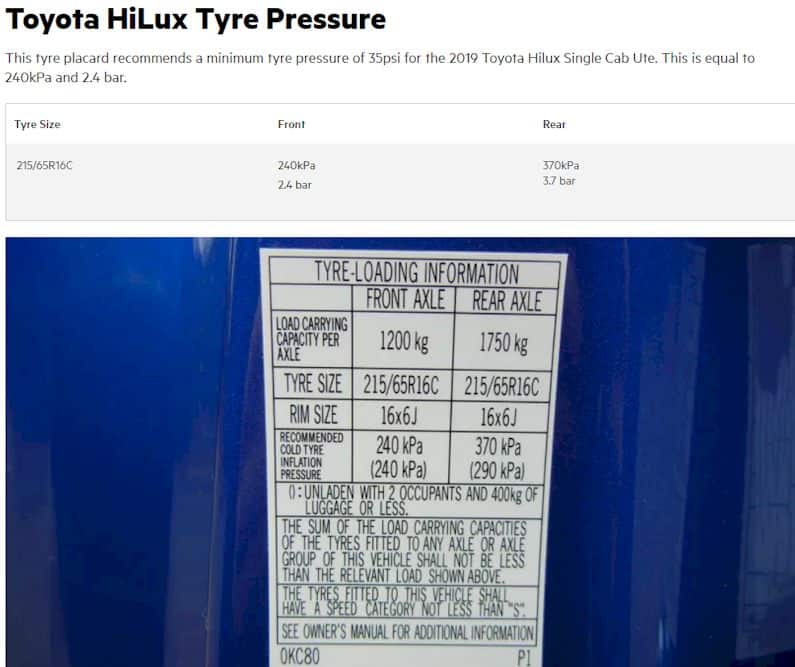
Toyota Camry tire pressure recommends 240 kPa or roughly 35psi, as shown in the photo below.
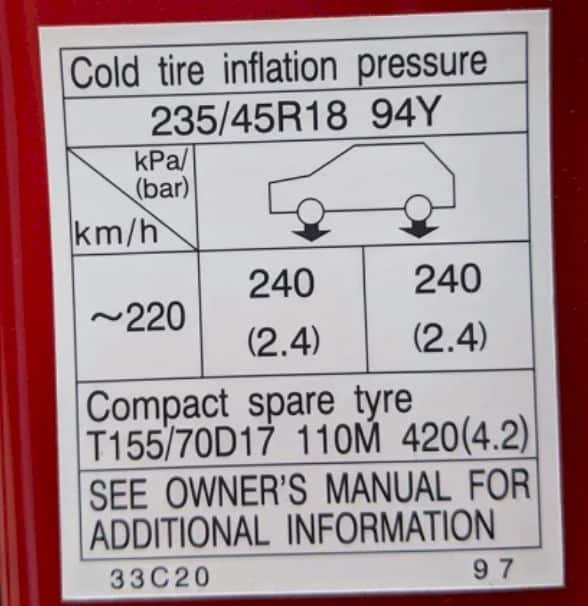
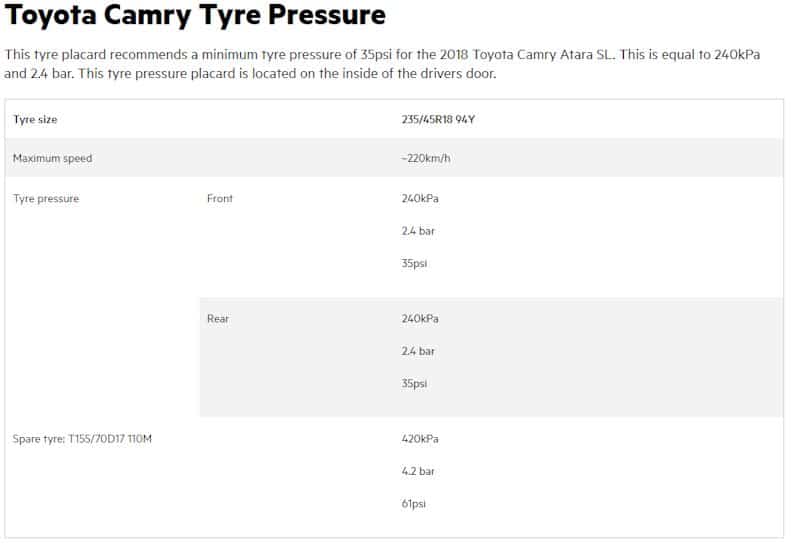
On the other hand, Honda Civic tire pressure is a little lower than that of Camry’s manufacturer recommendation.
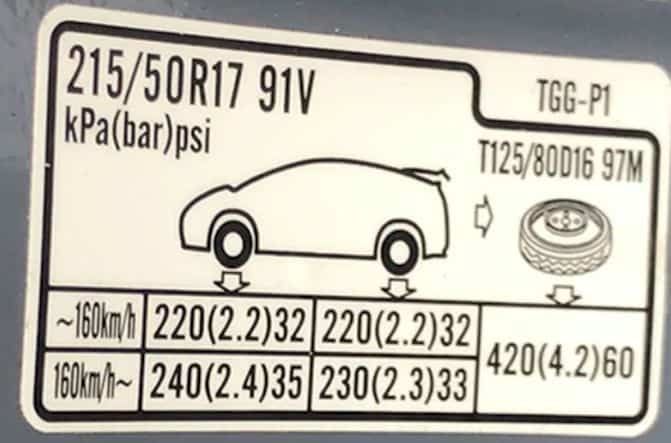
Here’s a snapshot of a Subaru Forester’s tire inflation guide. It has a more detailed guide depending on how many people and how much cargo are with you.
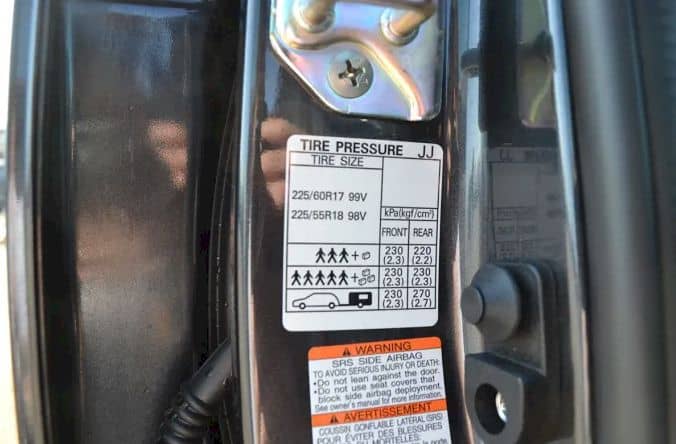
If you take a look at all the different examples from different vehicle types, you will notice that optimal tire pressure differs from every manufacturer and model of vehicle. For example, a pick-up truck requires the highest tire pressure inflation with cargo on board. In contrast, it has the lowest tire pressure inflation recommendation when not carrying the load. Pick up trucks are known to give bumpy rides, so, lowering tire pressure helps a bit on that.
If you will be towing something, Subaru Forester, a compact SUV, requires 270kPa (roughly 40psi). Stiffer tires for a different application that necessitates heavy load-bearing.
Sedans and other lighter vehicles usually fall under 30-35 psi recommended values. Such cars are not used for extreme applications and are built for the maximum ride comfort.
Now, how low is too low for tire pressure? Most TPMS will give a warning when your tire pressure is below 25% of the manufacturer’s recommendation. If you have been reading a lot about tire pressure and inflation guide, you will see many people saying that you should now fall below 10% of the manufacturer’s recommendation.
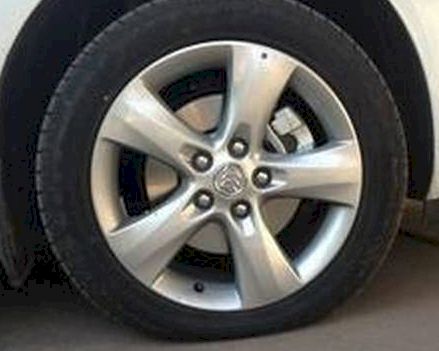
Running with low tire pressure means that more rubber is in contact with the pavement and can result in more friction. More friction means more surface area of the tire is hugging the road and increased fuel mileage, although, it gives you more grip. With more friction, more heat is generated. More heat means faster wear and tear.
Now, the bottom line is, if you are worried about obliterating your tires, you should go back to the fact that TPMS is triggered at 25%. It means that the past 25%, your car's performance will be severely affected. These parameters are placed before your car's condition becomes dangerous.
Following the 10%, guide is optimal and would ensure that your vehicle is performing at its fullest. But you should not be that worried if you fall under 10%. Just re-inflate your tires, and you're right.
For more details on finding the right PSI, check out "how much PSI in a car tire".
2. What Causes Low Tire Pressure
It's a bummer when you are on a long drive, and suddenly, your tires are losing pressure, especially if you are out on the weekend for a trip! This is why it's best to check your tire pressure before you leave! However, there are some low tire pressure causes that you may not be in control of.
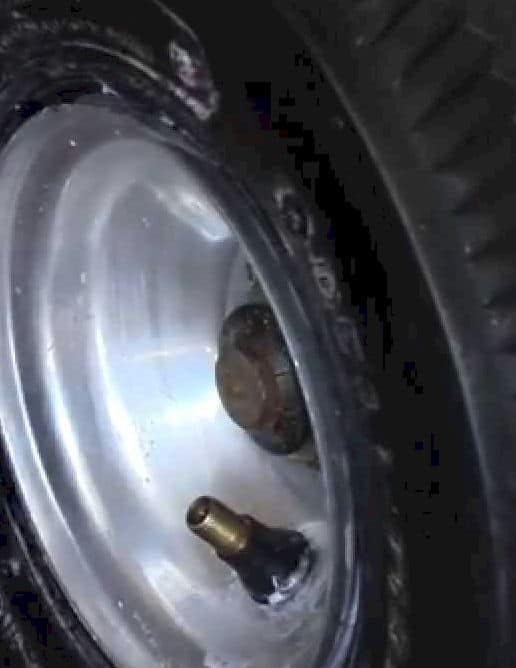
The two most common cause of low tire pressure is puncture and valve stem leak. Depending on the extent of the puncture or the damage of the valve stem, a leak can lead to flat tires as quick as a day up to a few days.
Another reason can be an imperfect seal between the wheel and the tire bead. This is not that common but can be mostly caused by bent wheels or tire damaged bead. Sometimes, though very rare, the tires may be deformed by a bump or a factory defect.
One more causes of low tire pressure that mechanics forget to tell laypeople is air temperature. If we look back to our basic chemistry, warm air has lower pressure compared to cold air, that’s why it rises!
So, when you fill tires with warm or room temperature air, pressure tends to go further down when the warm air gets cold, and the molecules condense. That's the primary reason why gaseous nitrogen is best used to inflate tires.
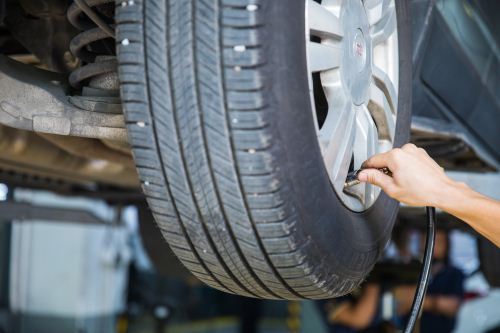
3. Low Tire Pressure in Cold Weather
Do you ever wonder why your tire pressure monitor lights up when it suddenly gets cold? Generally, your tire pressure decreases by 1 to 2 psi for every 10deg Fahrenheit. As autumn approaches, the temperature gets cold and guess what? The pavement cools your tires and the air inside it!
So, your tire pressure in cold weather decreases by a few psi. If you check your tire and the pressure dropped, during autumn and winter, it is unlikely that your tires leak. It can be attributed to the change in temperature.
If you are troubleshooting for a leak during the cold season, you may want to start by adding more air until you reach your desired air pressure.
Frequently check your tire pressure if it continues to decrease. If it doesn’t, then your problem is solved!
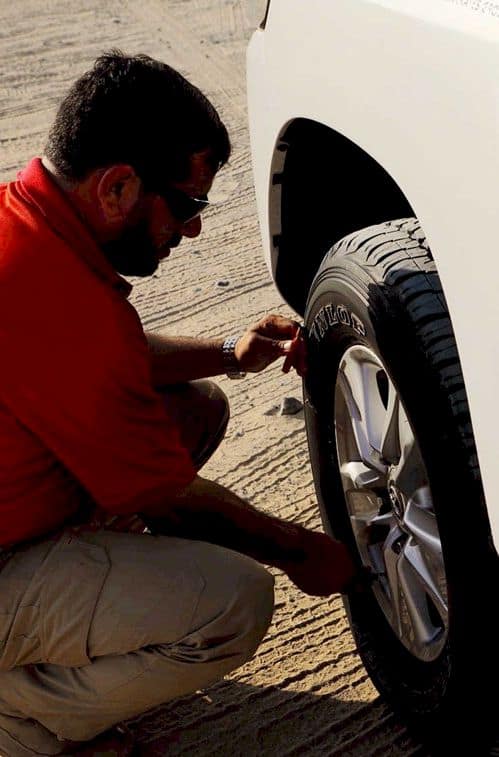
If tire pressure still decreases after adding more, then you should start checking for leaks.
4. Tire Pressure Light – What Does TPMS Mean
If you just recently bought a car and you don’t have car maintenance experience yet, most things are unfamiliar to you! As a driver, you are in charge of the maintenance of your car. So now, aside from the colorful display of your center console and dashboard, you have to watch out for warning lights to make sure that your vehicle is in top shape!
But since 12 years ago, this feature has become more readily available. Through the years, the sensor has become more sophisticated.
From a small TPMS light indicator, new model vehicles have an excellent descriptive display that indicates individual tire's air pressure and even tire temperature! When everything is well, your tire pressure light indicator will be off.
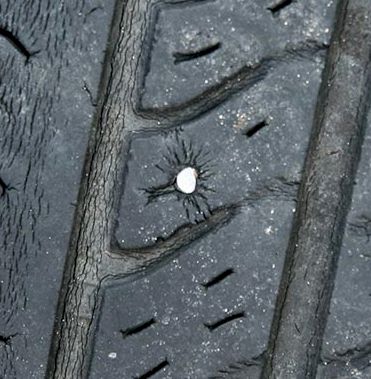
New car models can tell you precisely how much air pressure is inside your tire. This prompts you to add more air or relieve your tires of excess air. Older cars may not have individual indicators and prompts you to check your tire pressure and add more air.
5. TPMS For Car Brands
Different cars have different control panels and diverse displays. They don’t have a standard regulated format, and features vary for every model and maker. For example, a high-end Toyota Prius has a more advanced panel compared with a Toyota Corolla. Toyota TPMS sensor even varies for different models and vehicle types that they manufacture.
Here’s a photo of Subaru tire pressure light and monitor on the instrument panel. It is measured in psi and gives you how much pressure each tire has.
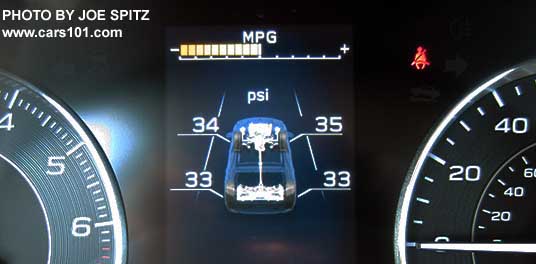
Take a look at this BMW warning symbol. This is an earlier model and displays that one of your tires has a low tire pressure. Remember, when the light comes on, your tire air pressure is 75% that of the manufacturer recommends. So, if the manufacturer recommends 35 psi, when your warning light first lights, one of your tires is below 26.25psi.
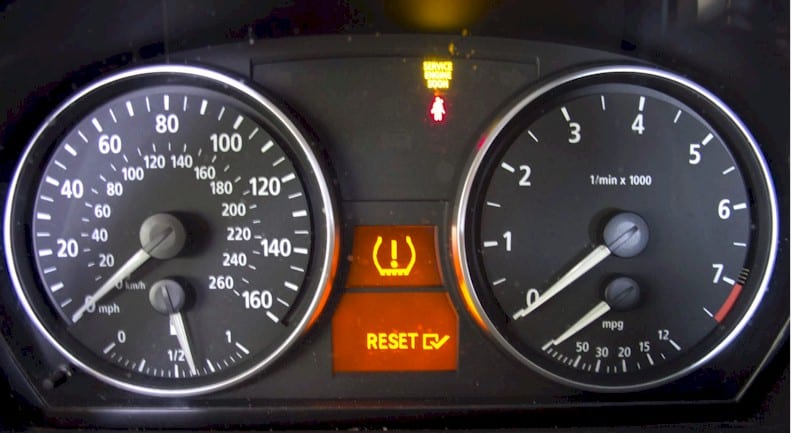
Another example of a TPMS light on honda pilot instrument panel.

Source: http://www.fixya.com/cars/t26411167-2011_honda_pilot_indicator
To cut it short, every manufacturer has its own way of telling you how much air pressure you got in each of your tires. Some are very detailed, while some are very limited to just telling you that one of your tires needs more air.
This is a clever feature that allows you to monitor your tire inflation without using a stick air gauge. It prompts you to inflate your tires to the optimal level to keep your vehicle in top shape. Remember, 10-15% lower air pressure than the manufacturer recommended level may not show visible signs. It helps that you can see how much air your tires have at a glance.
6. Check TPM System
A correctly working tire pressure monitor makes sure that you are safe whenever you ride your vehicle. It reminds you that you need to put more air in your tire, or else, you might end up with a flat tire! You wouldn’t want that, especially in the middle of a road trip!
However, is there a monitor that prompts you when your tire pressure monitor is broken? Oh no! There’s none! Now, it’s up to you to make sure to check the TPMS system of your car! If car manufacturers decide to have an indicator for your check TPM system failure, then it would be an endless string of monitor that monitors monitor! Get it?! Argh! That would be too complicated!
To make things simple, car manufacturers left that job to us. So, it’s up to us to “monitor the monitor.” At some point, your TPMS would fail. The sensors are inside the tires and are subject to the pressure inside your tires!
To cut the story short, there’s a quick way to check for your TPMS system. A TPMS scanner can be easily used to check all of your sensors to make sure that they are still working at optimal levels.
Some new models of OBD2 scanners have TPMS monitors already built on them, so, that’s quite nice. If you have a friend who owns one, you can probably borrow it and monitor your TPMS monitor. Sounds funny, huh? A monitor to monitor your monitor! That never gets old!
Aside from OBD2 scanners, there are some cheaper devices that are designed to monitor your TPMS sensor and reprogram it accordingly. You can get one online for as low as twenty bucks. Now, if you already own an OBD2 scanner, do include monitoring your TPMS regularly to make sure that your tire’s air pressure is always optimal.
You may be also interested on "what is Limp Mode".
7. Tire Pressure Sensor Fault
Tire pressure monitor fault may be caused by wear and tear. Older cars mean that some parts, like TPMS monitors, are due for replacement. These sensors are subject to the default tire pressure plus the bumps you get while driving. Although these sensors are built to withstand pressure, wear and tear will still eventually catch up.
If your tire pressure is low according to your TPMS sensor, inflate your tire, and the warning prompt should disappear. If the lights won't go off, it's a clue that there might be something wrong with the sensor. TPMS not reading one tire or when TPMS light on but tires are fine may indicate that it may be in error, or broken and needs replacement.
If you have an older vehicle, you have a limited view of your tire pressure sensor integrity. For starters, if its already broken and do not respond to the pressure changes inside the tire, you may end up with a flat tire without warning!
Newer models, however, especially high-end vehicles have sophisticated monitor system. For one, the individual report means that you don’t have to guess which tire needs inflation and gives you a clue if your sensor still works or not.
For example, if your monitor does not display pressure and temperature, there might be a TPMS error. A tire sensor fault does not necessarily mean that your sensor is broken beyond repair. It may have encountered an error and needs to be reprogrammed or reset.
For newer car models with advanced monitor display, you can quickly check individual tire sensors that post error. Older vehicles may require you to check all your tires to see which one is not responding.
Even high-end manufacturers and car models are not immune to wear and tear. So, also if you have a luxury vehicle, you should check out if your TPMS is getting faulty. Imagine, even GMC tire pressure sensor problems are common when the vehicle ages!
8. How to Tell Which TPMS Sensor is Bad
One of your primary concerns, I believe, is checking up and finding out which sensor has gone wrong. I know it's the primary reason you are here! This is the section where we give you an overview of how to fix a tire pressure sensor.
One of the most common questions that need to be addressed is “how to tell which TPMS sensor is bad.” If you do not have the patience to troubleshoot your vehicle, you better have it serviced! Of course, it costs a lot more! However, you pass the headache to the mechanic! Which, by the way, is not a headache for them because they know what to do!
But if you want to save a few bucks and learn something new, you can do it on your own! The first thing you need to know is which sensor is faulty. There are metrics inside your vehicle that tells you if your tire pressure is low. If your TPMS sensor is broken, your tire pressure display may show erroneous information. So, that’s your first clue.
High-end vehicles have more information available for you, and you may not need to troubleshoot each tire. Some consoles display error. So, that's pretty much it. No-fuss, no hassle. Just scroll and find TPMS information in your display and you will know which sensor has gone bad.
9. TPMS Reset
The next thing you want to do is to restore the function of your TPMS. After troubleshooting and finding out which sensor is faulty, depending on the extent of wear, you might need to reset or replace the whole sensor.
If it’s just tire pressure error, TPMS light resets on its own as soon as your tires are inflated to the manufacturer recommended settings. If it doesn’t revert to its default light setting, your sensor has to be reset or replaced.
If you are wondering how to reset tire pressure sensor chevy or how to reset Subaru tire pressure light, things may be a bit simple. Newer high caliber vehicles have advanced monitors that tell you what’s wrong.
If you have a few bucks to spare, you can purchase a TPMS sensor for as low as ten bucks! Of course, you have to check if the sensor you are eyeing to buy covers your car brand and model. These devices are easy to use. No fancy degree needed to navigate through it.
Scroll down and select your car model when the device is ready, place it in front of the valve stem. Remember, tire pressure monitors are integrated with the valve stem.
The sensor commonly reads the tire pressure and temperature of the air inside the tire. It will display an error if your TPMS device is malfunctioning or broken.
Before you decide to buy a replacement, you should try to TPMS reset using your sensor first. If this doesn’t solve the problem, then you probably really need a replacement.
Other TPMS sensors costs above a hundred bucks and you may want to steer away from it if you are trying to save some for a sensor. However, if you’re now worried about the cost, typically these models have broader manufacturer and vehicle coverage.
On the same subject but different concern, some sensors may be giving you erroneous readings. When your sensor says that your front left tire is soft, and upon checking you see that your rear left tire is soft instead of the front left, it may be a programming error. You can choose to reprogram or relearn your sensors and correct it.
10. How Much Does it Cost to Replace a Tire Pressure Sensor?
Tire pressure sensors do not cost a fortune. However, they are not cheap as well. Most cars now have factory-installed TPMS and spare parts are readily available. However, a lot of cheapos and knockoffs are flooding the market.
The problem with these bootleg is quality. Tire pressure monitors are always under pressure and temperature changes. If you replace your sensors with one of the sissy sensors, they may not last under extreme conditions.
Be warned about the price. They usually suggest quality. The cost to replace TPMS sensors varies between brands. You can find replacement parts for as low as $40 up to $200. You can choose between generic and non-brand specific sensors, or you can opt for a replacement from your car manufacturer. Of course, the ones you get from the car manufacturer has a higher premium, but it usually comes with a longer warranty and higher quality.
11. Last Words
Low tire pressure is something that we don't get to feel while driving easily. Especially with all the paved roads and freeways, you might not notice that your tire has low pressure. A significant amount of air pressure has been lost when your ride comfort is affected.
When your TPMS light warning lights up, your already 25% below the recommended tire pressure, well, at least you get to notice it before you get a flat tire. Some newer car models, however, have an advanced display that shows you how much pressure you have and also tells your tire air temperature.
It’s quite a nifty feature that gives you a real-time update of your tire’s status. This gives you the opportunity to add more air as needed. With the right tire pressure, you get to be always on the safe side. And you know what, it doesn’t hurt to have those fuel savings!
Correct tire inflation means that your tires are erect as recommended and intended by the car manufacturer. More tire surface on the road means more friction more fuel consumption. The right inflation means that the amount of tire surface in contact with the ground is the right proportion for optimal engine performance!
Now, in the event that your tire pressure monitoring system becomes faulty, you can always manually check for your tire pressure. However, this may be troublesome and, still, the best solution is to have it fixed.
TPMS monitoring systems are not immortal and are subject to natural wear and tear. These parts are under heavy air pressure and catch the bumps you encounter on the road. Extreme weather and driving condition may result in an error, or sometimes, may even break your sensor.
You can opt for a TPMS troubleshooting device to check if your sensors are broken or just had an error. The basic device runs around twenty bucks while the TPMS device monitor can go over a hundred.
After checking your sensors, you can confirm if you really need to have your sensors replaced. Third-party generic sensors are way cheaper than OEMs, but, you may not be able to rest on the quality. If you are on a tight budget, generics will work fine; they might not last that long.
If your car is still under warranty, you may want to discuss with the car manufacturer to see if you're still covered. If you are still covered by warranty, you are in great luck! You won't have to pay for it! However, if you have some years under your car, you may need to shoulder the expenses by yourself.
Typically, generic sensors cost as low as $40. These sensors are not brand specific. However, some models may not work properly with your instrument panel monitor. Using a sensor model that your car manufacturer recommends is the safest choice! They may even come with better warranties than the generic third party manufactured products.
Now, let’s recap what we have learned.
- Correct tire pressure makes sure you don’t skid from your lane.
- Right tire pressure optimizes fuel economy.
- TPMS light is triggered when your tire pressure is below 25% of the recommended value.
- Tire air pressure loses a few points when the weather gets cold.
- Lit TPMS indicator means that you are below the recommended tire pressure and you must add more air to your tires.
- When tire pressure indicator doesn’t turn off after inflating your tires, your sensor may be damaged or broken.
- You don’t have to spend a fortune to troubleshoot your sensors.
- Some OBD2 scanners can troubleshoot your sensors. see the guide to reading OBD2 codes.
Before you decide to buy out of your pocket, make sure that you are outside the warranty period! Now, if you still got a warranty, you’re in for a treat!
Simon graduated with a Mechanical and Electrical Engineering Degree. He has over 20 years of servicing experience in both Japanese and German car dealerships. He now acts as a freelance mechanic’s instructor for local schools.
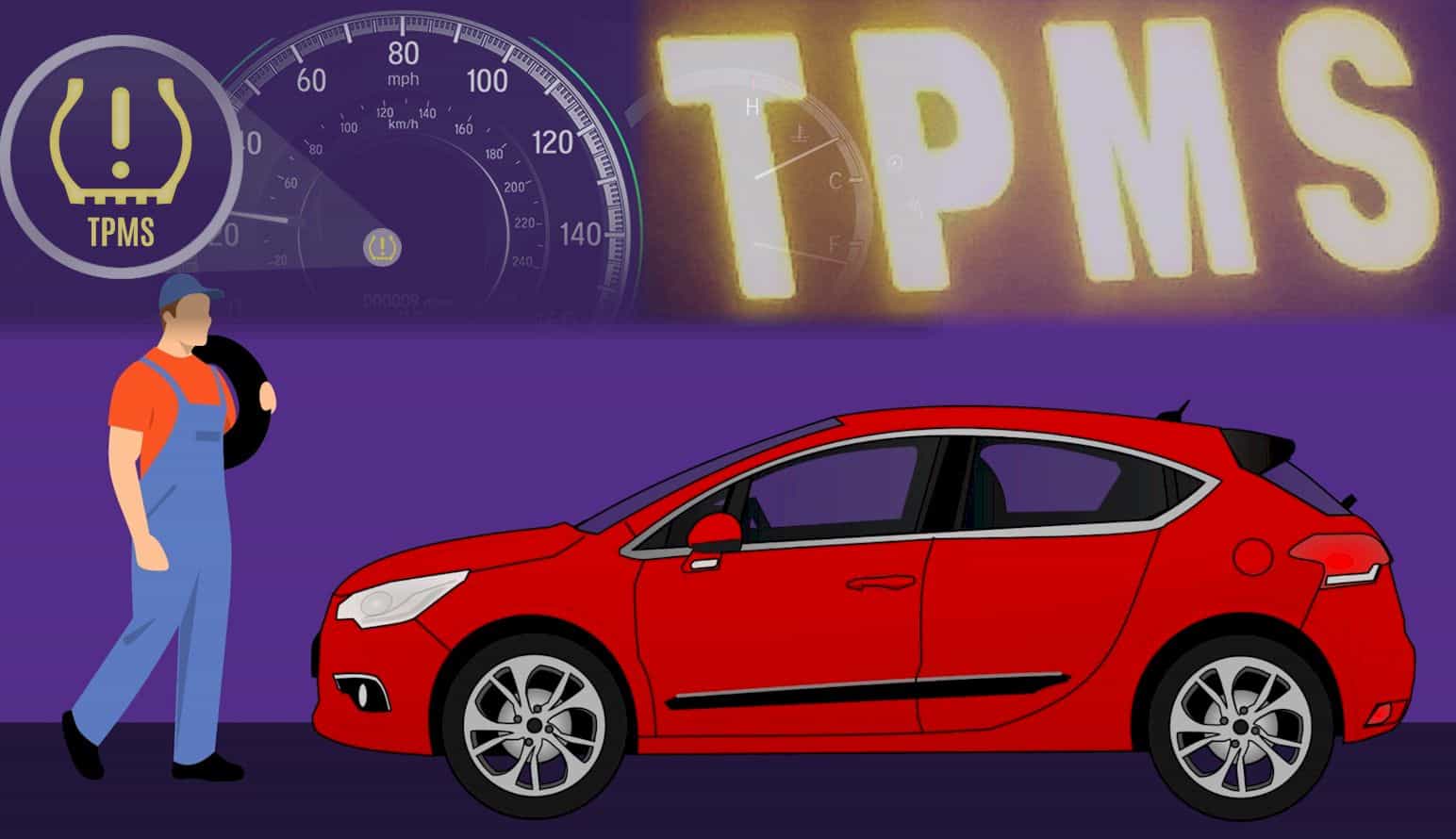

I never thought about more friction being produced and therefore more heat from having more of the tire exposed due to low pressure. This is scary to think about! Now I’m going to check my tire pressure!
Good point about temperature messing with the tire pressure sensors over time. I live up north where it’s so cold. I bet mine wears out faster than normal.
I wish my car had the tire temp readings. Maybe it will be on my next one.
Man my BMW always had this alert pop up!